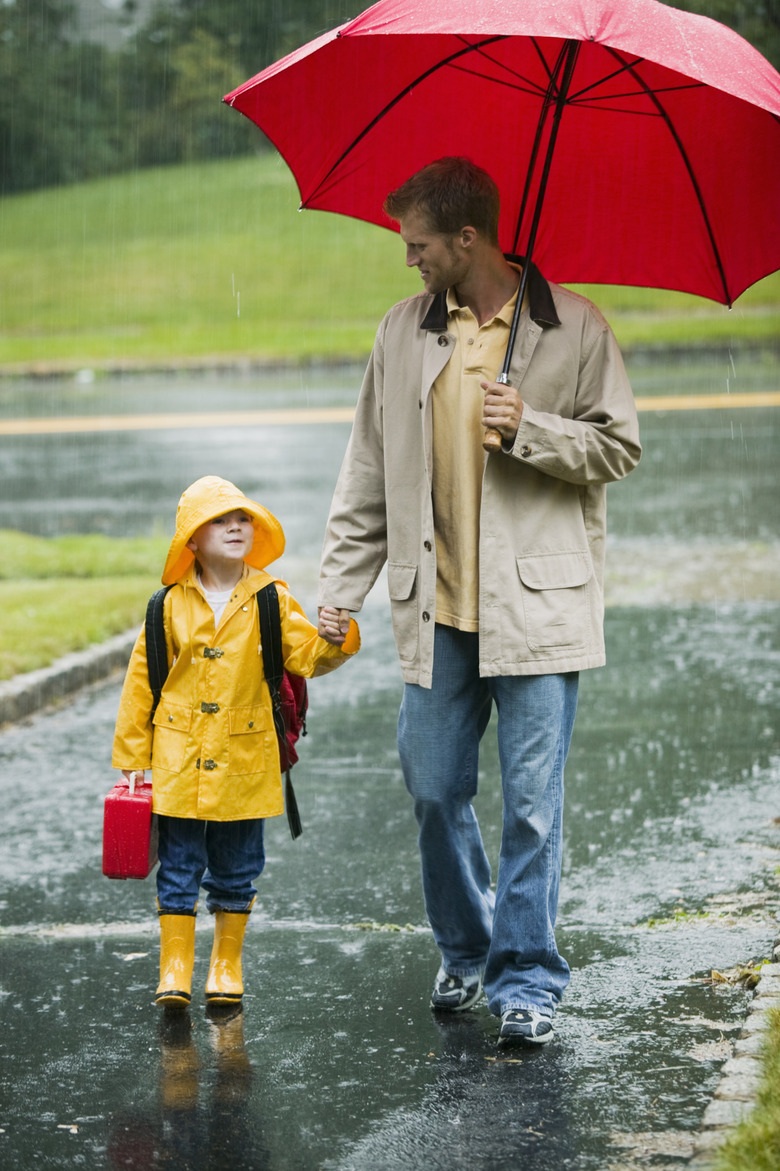What Is Responsible For Raindrops Falling To Earth?
Raindrops, along with all things that fall, drop to the Earth because of gravity. Yet, the process that raindrops undergo to get to the point where they fall is a little more complicated than a simple gravitational effect. To become rain, water must first transform to a gas, travel up into the atmosphere and then transform back again to a liquid. Only then do the raindrops succumb to gravity and fall out of clouds. The process during which water transforms to rain and falls is known collectively as the hydrologic cycle.
A Never-Ending Story
A Never-Ending Story
The hydrologic cycle is also known as the water cycle, a continuous process with no starting or ending point. The cycle involves nine parts, each having to do with what water does at any given stage of the cycle. For instance, during the evaporation stage, the sun heats liquid water, turning it to a gas that then floats up into the atmosphere. Once there, the gas cools and condenses — that is, it changes back to liquid. After condensation, precipitation can occur. During precipitation, rain, snow or ice falls to Earth's surface. Once on Earth, the water may evaporate again and return to the atmosphere.
Water on the Move
Water on the Move
If you've seen a mirror or eyeglasses fog up, you've witnessed condensation, when water vapor in the air cools and changes to a liquid. Condensation also creates clouds, as water molecules join with dust, salt or smoke to form drops. These drops join with one another, the clouds and water drops growing and becoming visible. The clouds float in the atmosphere, supported by the denser air below them. The wind carries the clouds, carrying water to different parts of the globe.
A Precipitous Matter
A Precipitous Matter
Just because water has collected into clouds doesn't mean it will automatically rain down on Earth in the water cycle process known as precipitation. Even though gravity is pulling down on raindrops, air updrafts are pushing them up. Instead, raindrops in the cloud, millions of them, must collide to become drops that are big enough to overcome the updrafts. Sometimes instead, raindrops start as ice crystals. Water condenses on the crystals, growing them until they reach a size large enough to fall as snow or ice. On the way to Earth this freezing precipitation may melt into rain.
Raindrops on Roses
Raindrops on Roses
Rain may fall on to water or land, some of the liquid evaporating and traveling up, some traveling down through soil, and some carried over land to streams, lakes and oceans. Plants may intercept rain as well. The vegetation gives it back through transpiration, water vapor leaving the plant through pores on the leaves. No matter where rain lands, none of the water is actually lost during the hydrologic cycle. Instead, all of the Earth's water, the same water the Earth has had for 3.5 billion years, recycles through the water cycle.
Cite This Article
MLA
Johnson, Sophie. "What Is Responsible For Raindrops Falling To Earth?" sciencing.com, https://www.sciencing.com/what-is-responsible-for-raindrops-falling-to-earth-12732099/. 7 March 2014.
APA
Johnson, Sophie. (2014, March 7). What Is Responsible For Raindrops Falling To Earth?. sciencing.com. Retrieved from https://www.sciencing.com/what-is-responsible-for-raindrops-falling-to-earth-12732099/
Chicago
Johnson, Sophie. What Is Responsible For Raindrops Falling To Earth? last modified March 24, 2022. https://www.sciencing.com/what-is-responsible-for-raindrops-falling-to-earth-12732099/
